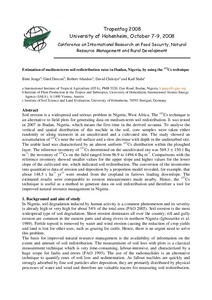| dc.contributor.author | Junge, Birte |
| dc.contributor.author | Dercon, Gerd |
| dc.contributor.author | Abaidoo, Robert C. |
| dc.contributor.author | Chikoye, David |
| dc.contributor.author | Stahr, Karl |
| dc.date.accessioned | 2019-12-04T11:14:41Z |
| dc.date.available | 2019-12-04T11:14:41Z |
| dc.date.issued | 2008 |
| dc.identifier.citation | Birte, J., Dercon, G., Abaidoo, R.C., Chikoye, D. & Stahr, K. (2008). Estimation of Medium-Term Soil Redistribution Rates in Ibadan, Nigeria, by using the 137Cs Technique: Proceedings of Tropentag: Conference on International Research on Food Security, Natural Resource Management and Rural Development, University of Hohenheim, 7-9 October, 2008. Stuttgart: University of Hohenheim. |
| dc.identifier.uri | https://hdl.handle.net/20.500.12478/2829 |
| dc.description.abstract | Soil erosion is a widespread and serious problem in Nigeria, West Africa. The 137 Cs technique is
an alternative to field plots for generating data
on medium-term soil redistri
bution. It was tested
in 2007 in Ibadan, Nigeria, which means the firs
t time in the derived savanna. To analyse the
vertical and spatial distribution
of this nuclide in the soil, core samples were taken either
randomly or along transects in
an uncultivated and a cultivated
site. The study showed an
accumulation of
137
Cs near the soil surface and a slow decr
ease with depth in the undisturbed site.
The arable land was characterized by an almost uniform
137
Cs distribution within the ploughed
layer. The reference inventory of
137
Cs determined on the uncultivated site was 569.3
±
150.1 Bq
m
-2
; the inventory of
137
Cs on the field ranged from 96.9 to 1494.4 Bq m
-2
. Comparisons with the
reference inventory showed smaller values for
the upper slope and higher values for the lower
slope of the cultivated site, wh
ich indicated soil redistribution.
The conversion of the inventories
into quantitative data of erosi
on and deposition by a proportion model revealed, for example, that
about 148.5 t ha
-1
yr
-1
were eroded from the cropland in furrows leading downslope. The
estimated results were comparable to erosion measurements made nearby. Hence, the
137
Cs
technique is useful as a method to generate data
on soil redistribution a
nd therefore a tool for
improved natural resource management in Nigeria. |
| dc.description.sponsorship | Deutsche Gesellschaft für Internationale Zusammenarbeit |
| dc.language.iso | en |
| dc.subject | Soil Erosion |
| dc.subject | Soil Redistribution |
| dc.subject | Cs Technique |
| dc.subject | Fertile Topsoil |
| dc.subject | Uncultivated And A Cultivated Site |
| dc.subject | Inventory |
| dc.subject | Radionuclides |
| dc.subject | Improved Natural Resource Management |
| dc.title | Estimation of medium-term soil redistribution rates in Ibadan, Nigeria, by using the 137 Cs technique |
| dc.type | Conference Paper |
| dc.description.version | Peer Review |
| cg.contributor.affiliation | International Institute of Tropical Agriculture |
| cg.contributor.affiliation | International Atomic Energy Agency |
| cg.contributor.affiliation | Universität Hohenheim |
| cg.coverage.region | Acp |
| cg.coverage.region | Africa |
| cg.coverage.region | West Africa |
| cg.coverage.region | Europe |
| cg.coverage.country | Nigeria |
| cg.coverage.country | Austria |
| cg.coverage.country | Germany |
| cg.authorship.types | CGIAR and advanced research institute |
| cg.iitasubject | Natural Resource Management |
| cg.iitasubject | Soil Fertility |
| cg.iitasubject | Soil Health |
| cg.iitasubject | Land Use |
| cg.iitasubject | Baseline Survey |
| cg.iitasubject | Soil Information |
| cg.iitasubject | Soil Surveys And Mapping |
| cg.iitasubject | Integrated Soil Fertility Management |
| cg.accessibilitystatus | Open Access |
| local.dspaceid | 93930 |

